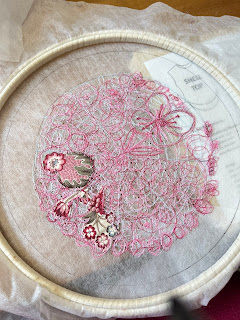I love to take my time over preparing a pretty table & menu for friends, even if it is a relaxed meal. It says someone has taken time over & given thought to many things like the weather (summer hot), the season (summer solstice) and the friends visiting.
Using coloured glass brings in a freshness to a table setting & I enjoy using mine. It is not dishwasher proof so they are all rinsed by hand, a small price to pay for enjoying them.
For the Summer Solstice, my menu harked back to living in Africa & hot summers travelling in Europe ...
This is what I made -
Spatchcock chicken - with a zingy lemon, lime & ginger marinade, it always cooks better this way
New potatoes with lots of mint from the garden to give them that minty summer freshness
Carrot & pineapple salad with an orange dressing - a summer favourite in Africa, made ahead so it is cold & refreshing. I did not add currants because not everyone eats them
Green salad with cucumber, mange tout, green beans, tiny pepper rings, feta, radish, home made black pepper & thyme croutons. Salad bits served separately for choice because of guests preferences
Shopska salad (I enjoyed this in Sofia in Bulgaria) diced tomato, cucumber, peppers, red onion, feta, red wine vinaigrette . I added a little honey to take off the sharpness & made it ahead of time for flavours to develop ...

A traditional
Bulgarian restaurant & menu in Sofia on our trip across Transylvania. This very traditional restaurant was close to our hotel & it had beautiful authentic decor.
Shopska salad was regularly served with our meals across Belgrade, Sofia, Plovdiv, Veliko Tarnovo & Arbanasi
It was all absolutely delicious & light enough for a very hot summers evening while we mulled over how the first half of the year had been. No year is without challenges & changes; it is how we ride the storms so they don't engulf us.
We all agreed that it has been too hot for anything other than lots of salads with meat or fish, with jugs of iced water or tea.
Pudding / desert was a British classic of Eton Mess. It is strawberry season & they were just ripe.
I made a mixed berry compote ahead of time to drizzle over it all & add that softness that is needed.
All prepared ahead of the time & everyone assembled theirs as they liked.
We decided on a refreshing mango sorbet instead of ice-cream. It always looks better served in glass bowls & these coloured vintage ones are perfect with their deep bowl.
We took our pudding out on the patio to catch the early evening breeze - easy enough to enjoy outdoors in the cool softening light.
We enjoyed my friend's freshly baked lemon drizzle cake to finish it off - a lovely evening just catching up while the candles burnt low.
The conservatory sideboard is the perfect place to set up & serve such meals from - convenient for everyone to help themselves to what takes their fancy & to return for seconds.
This space is used the most for meals with its views over the garden & wide doors to catch the breeze too.
I hope the next 6 months to the Winter Solstice is as blessed for everyone. Thank you for stopping by, each & every visit is appreciated.
Dee ☀️🥗🏡💚




























